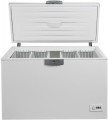Capacity
The total working volume of the freezer compartment. A larger volume allows for more products to be stored, but it affects the size and cost of the unit; therefore, when choosing based on this parameter, it's important not to chase maximum capacity but to consider what volume you actually need. For example, for household use, the average necessary volume is 50 liters per person; and when choosing a display freezer (see "Type"), you need to consider the number of products to be sold. More detailed recommendations for selecting the optimal volume can be found in specialized sources.
It is also worth considering that the freezer is often divided into several compartments (see below) — which means that a large volume does not necessarily guarantee that large pieces of products can fit into the device.
Hanging baskets
One or more removable baskets that are attached to the top of the freezer compartment.
Hanging baskets are made of both metal and plastic and are designed to store shallow frozen items or frequently used products that require quick access. Hanging baskets are also used to separate different types of contents.
Freeze capacity
One of the main indicators of freezer performance is the approximate amount of fresh food that the freezer can completely freeze from room temperature to the minimum operating temperature in 24 hours. For domestic use, a power of 10-15 kg/day is considered quite sufficient. More performant models may be required if you have to freeze a lot of food at a time or for industrial purposes.
Fast freeze
It is the forced freezing mode, in which the temperature inside the freezer is briefly reduced to -24 °C. This mode is intended for the case when you need to freeze numerous products at the same time — without a sharp decrease in temperature, the heat from numerous non-frozen products could lead to its critical increase.
Usually, the fast freeze mode must be turned on in advance — 5 to 6 hours before loading the products. Thus the freezer has time to decrease the temperature in the chamber. In this case, it is necessary to take into account the increased load on the compressor — it is impossible to turn on fast freeze for a long time. In some models, automatic shutdown of the fast freeze mode is provided. In some, it must be done manually.
Lighting
Freezer interior lighting system. This function is very helpful given that the working chamber of the unit, even with the door open, is often shaded, and it is not so easy to see its contents. The lighting usually works automatically — similar to how it is implemented in refrigerators: the light turns on when the door is opened and turns off when it is closed.
Mechanical lock
If a child lock provides for electronic locking of controls, then
mechanical lock is a lock for the door, which can be opened with a key. This solution is in high demand in chest freezers intended for non-domestic use.
Energy consumption per year
It is the average amount of energy consumed by the freezer in a year of operation. Of course, these figures are not absolutely accurate. The actual power consumption may vary depending on the specific operating conditions. However, this parameter makes it possible to evaluate the consumption of the device and compare different models with each other. At the same time, it often turns out to be more convenient and visual than the energy consumption class (see above) because, in this paragraph, we are talking about a specific figure (from which you can also calculate the cost of electricity consumed).
Climate class
The climate class to which the freezer corresponds.
As the name implies, this parameter describes the environmental conditions for which the unit is designed. The warmer it is around, the more powerful the freezer should be and the better thermal insulation it should have. Specific classes are indicated by letters. Here are the most popular options:
— SN (subnormal). Models for a cool temperate climate have an operating range from +10 °C to + 32 °C. Such a unit can be useful in a poorly heated room where the temperature can drop below +16 °C — for example, on the veranda of a private house, in a garage, etc.
— N (normal). Freezer for a temperate climate, with an operating temperature range of +16...+32 °C. Such a unit is suitable for most residential apartments and houses in mid-latitudes.
— ST (subtropical). Models for subtropical and humid tropical climates. Normally they work at the range of external temperatures +18...+38 °C.
— T (tropical). Refrigerators for dry tropical climates. Designed for temperature range +18 °C to +43 °C.
Also, note that there are many models on the market with an extended temperature range covering several classes. For example, a unit labelled N-ST will have a temperature range of +16...+38 °C. These freezers are indispensable in climates, conditions which are not covered by one standard class — for example, in cold winters and hot summers.
Operation at sub-zero temperatures
The ability of freezer to work at sub-zero temperatures allows you to take it out to an unheated room. And chest freezers can be used outdoors.

